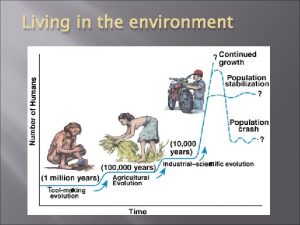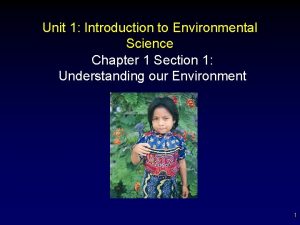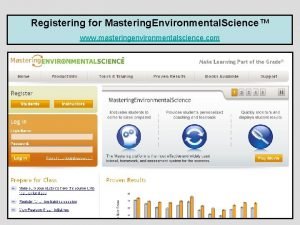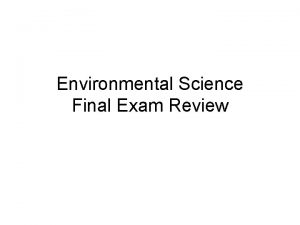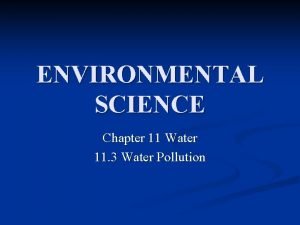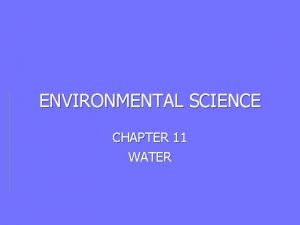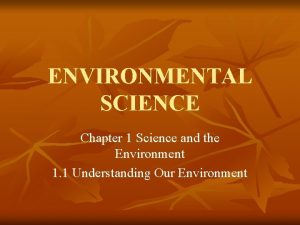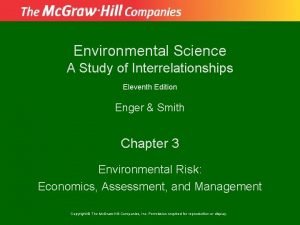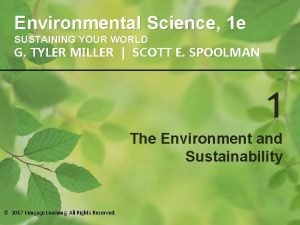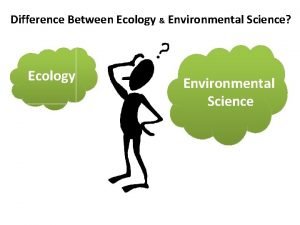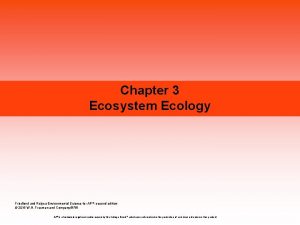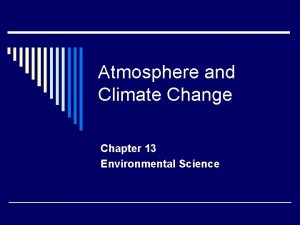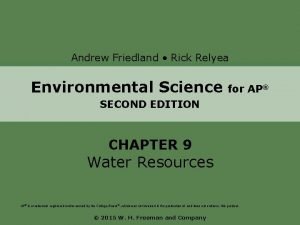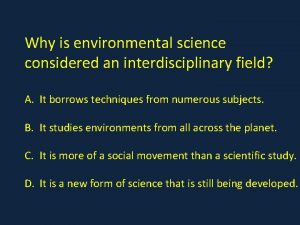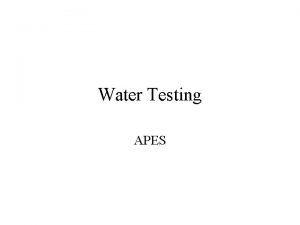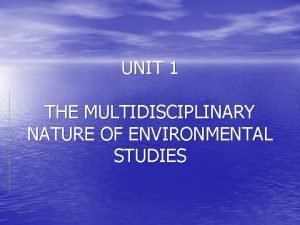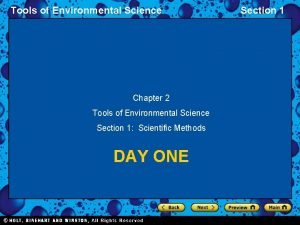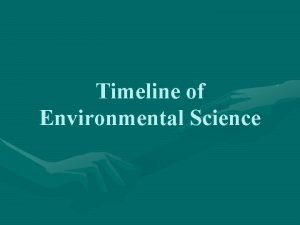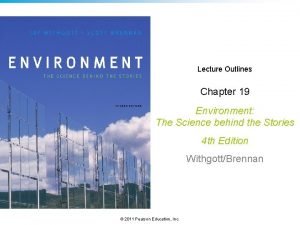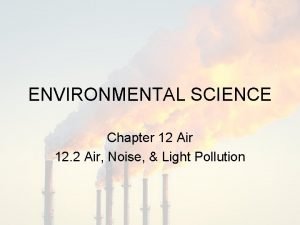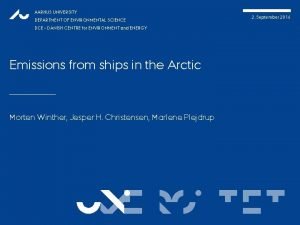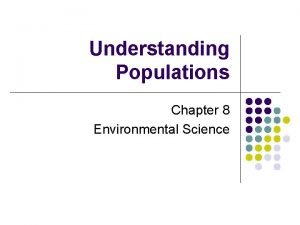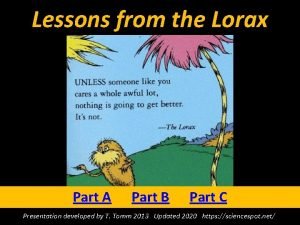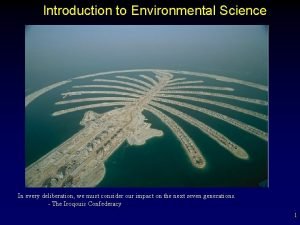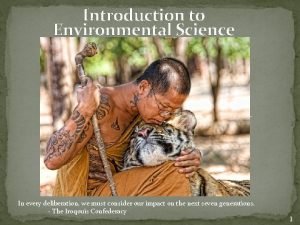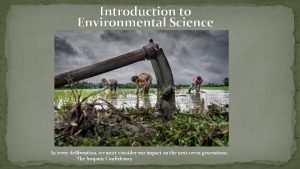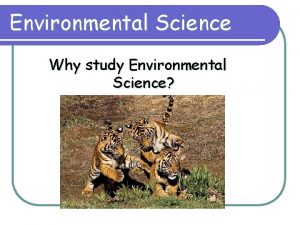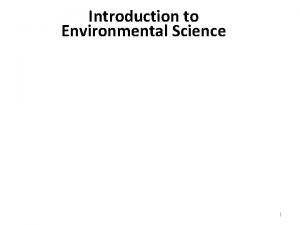Introduction to Environmental Science In every deliberation we

Introduction to Environmental Science In every deliberation, we must consider our impact on the next seven generations. - The Iroqouis Confederacy

Environmental Science �Environmental science is the study of the interaction of humans with the natural environment. �The environment includes all of the living and nonliving things that we interact with. � Climate � Soil and landforms � Water sources � Other living organisms 2

�Environmental science and the issues that it studies are complex and interdisciplinary, meaning it incorporates concepts and ideas from multiple fields of study. 3

Environmental History �Humans have impacted the Earth since the very beginnings of civilization. �In 2400 B. C. , the agricultural fields of Sumeria had grain production similar to modern agriculture – about 30 bushels per acre. �The Sumerians relied on irrigation, the artificial application of water from another source. � Tigris and Euphrates rivers. 4

�All water contains small amounts of minerals called salt, and that salt built up in the Mesopotamian soil over time. � Yields declined to half, then a fourth within a few hundred years. � By the 7 th century A. D. , slave labor had to be used to strip the upper salt layer from the soil so it could still be farmed. � By the 16 th century, the Fertile Crescent of Mesopotamia was a salty wasteland. Tigris River, Diyarbakir, Turkey. 5

�This is an example of two important concepts in environmental science: � The Law of Unintended Consequences, which states that the actions of people and governments always have unexpected effects. � Unsustainability, a condition that cannot continue at its current rate. 6

The Tragedy of the Commons �An ecologist named Garrett Hardin wrote an essay called “The Tragedy of the Commons”, describing a major source of environmental conflict: �Commons, or areas that are shared and not owned, are likely to be depleted as individuals pursue their own self-interests. �Tragedy of the Commons TED Talk 7

�Two small villages consist mostly of farmers that raise and sell sheep at a nearby city. � The first village has a common pasture that all villages have unrestricted access to. � The second village has a pasture that has been divided up, which each section owned by a famer. �Which village will be more likely to experience resource depletion, where a resource is consumed faster than it can be replaced? Nearpod 8

�Climate change, air pollution, water pollution, and overfishing of international waters are all modern examples of the Tragedy of the Commons. Norilsk, Russia Source: ecojunk. wordpress. com Zadar, Croatia Source: Agence France-Presse 9

The Lorax 10

The Progressive Era �In the United States, the first environmental movement began with a series of conservation measures taken by President Teddy Roosevelt. � The goal was to prevent the resource depletion and the destruction of commons through unsustainable logging and hunting. Redwood lumberjacks, Humboldt County, California. 11

�National Parks are preserved areas that are relatively unaltered from their original state. � No fishing, logging, commercial hunting, or livestock grazing can occur. �National Forests are federally- managed, but do allow commercial logging and recreational hunting and fishing. �National Wildlife Refuges do not allow commercial activities, but may allow recreational hunting and fishing. Nearpod 12

13

Hetchy Debate �Years after the National Parks system was established, the city of San Francisco experienced an earthquake, followed by a massive fire. �About 90% of the damage was due to the fire, which exposed the city’s inadequate water supply. "San Francisco 1906 fire 02 DA-SN-03 -00958" by Harry Sterling Hooper. 14

� The city applied to the federal government to construct a reservoir in the Hetchy valley of Yosemite National Park. � In order for the dam to be constructed, a law would have to be passed by Congress and signed by President Woodrow Wilson. Nearpod 15

Environmental Ethics �The Hetchy debate led to the emergence of two major philosophies or environmental ethics; the moral relationship that humans have with the environment. 16

�Anthropocentrism is a human-centered philosophy that protects and promotes of human interests or well-being at the expense of all other factors. � Biggest advocate: Gifford Pinchot, the first chief of the U. S. Forest Service. �Ecocentrism is a nature-centered philosophy that places intrinsic value on ecosystems regardless of their usefulness to humans. � Biggest advocate: John Muir, founder of the Sierra Club. 17

� Result of the Hetchy Debate: Construction of the dam began in 1914. It is still in use today. � Gifford Pinochet summarized his Conservation ethic and decision making as: "Where conflicting interests must be reconciled, the question shall always be answered from the standpoint of the greatest good of the greatest number in the long run. “ Nearpod 18

�Conservationists during the Progressive Era were the most concerned about resource depletion. They categorized natural resources into four groups: �Inexhaustible resources cannot be used up. � Sunlight. �Renewable resources can be replaced, but the process may take a long time. � Timber, soil. �Nonrenewable resources are consumed faster than they replenish, as their formation took millions of years. � Coal, oil, natural gas. �Recyclable nonrenewable resources also are not replaced at the rate they are used, but can be used more than once. � Iron, aluminum, copper. Nearpod 19

Modern Environmentalism �A series of major environmental disasters through the early 20 th century raised awareness of many other environmental issues besides resource conservation. 20

�In 1935, Cane Toads were introduced into Australia to help control the greybacked cane beetle, a pest insect destroying sugar cane crops. �The toads became an invasive species, overpopulating in its new environment and outcompeting or harming native species. 21

� A dense smog of from a zinc plant in Donora, Pennsylvania in 1948 sickened thousands. � This was one of the deadliest incidents of air pollution, the introduction of particles or gases into the atmosphere that are harmful to living organisms. 22

� Radioactive fallout from nuclear bomb testing in the Marshall Islands exposed native islanders and Navy sailors to radioactive fallout. � This material was carcinogenic, meaning it increased the risk of cancer. 23

�A major oil spill near the city of Santa Barbara in 1969, coupled a fire on the Cuyahoga river that same year left powerful images of the effects of water pollution, the contamination of lakes, rivers, oceans, and groundwater. 24

� Rachel Carson published the book “Silent Spring” in 1962, documenting the effects that indiscriminate spraying of pesticides like DDT were having on the environment. � Many of these pesticides were persistent pollutants, meaning they resist normal environmental degradation. � Biodegradable pollutants will decompose over time. 25

Rachel Carson’s “Silent Spring” 26

�Many species, such as the whooping crane, nearly disappeared completely from the wild due to overhunting and habitat loss. �This raised awareness of the problem of extinction, where a species disappears from the Earth completely. 27

�Extinction is a normal process, with a background extinction rate of 1 -5 species per year. � The current rates of extinction are 1, 000 -10, 000 times that. �Extinction lowers the biodiversity, or amount of variation of species and genes within an area. 28

�Rapid increases in the population size of countries like India and China caused fears of human overpopulation and famine, an extreme scarcity of food. �One prediction from the book, The Population Bomb: “The battle to feed all of humanity is over. In the 1970 s hundreds of millions of people will starve to death in spite of any crash programs embarked upon now. At this late date nothing can prevent a substantial increase in the world death rate. . . ” 29

� In 1978, homes in the city of Love Canal, New York, were abandoned due to leakage from a massive chemical waste dump near the elementary school. � This was hazardous waste; compounds that are especially dangerous to the environment and human health. 30

Laws and Regulation �A series of laws were passed in response to the modern environmentalism movement. � The Safe Drinking Water Act, which regulates the testing and contents of municipal tap water. � The Clean Water Act, which restricts pollution of surface waters. � The Clean Air Act, which restricts pollution of the atmosphere. � The Resource Conservation and Recovery Act, which describes rules for handling toxic and hazardous waste. � The Endangered Species Act, which lists species at risk for extinction and plans for their recovery. � The creation of the Environmental Protection Agency (EPA), which is charged with enforcing these and other laws. 31

Global Environmentalism �Many of those same environmental issues persist today, but are increasingly complex to deal because they are spread throughout the entire world, not just a single country. �Environmental indicators are used to describe and evaluate the health of Earth’s ecosystems. � Biodiversity � Food production rates � Climate change � Human population growth � Resource depletion 32

The Demographic Divide �Countries are classified into one of two categories based on their economic status. �Developed countries tend to be wealthier, have higher rates of education, advanced infrastructure, and an overall better standard of living. �Developing countries tend to be poorer, less education, have inadequate infrastructure, and a lower standard of living. Border between Bhutan (left) and India (right). 33

�Significant differences include: �Gross domestic product (GDP) per capita, a measure of the monetary value of the goods and services produced person. � Higher in developed countries, lower in developing. �Total fertility rates, the number of children born to an average woman. � Higher in developing countries, lower in developed. Border between Bhutan (left) and India (right). 34

�Life expectancy, the number of years an average person will live. � Higher in developed countries, lower in developing. �Environmental regulations and worker protections tend to be weaker, unenforced, or nonexistent in developing countries. Border between Bhutan (left) and India (right). 35

U. S. Japan India Haiti Life Expectancy 79 83 66 62 Total Fertility Rate (births per woman) 1. 93 1. 39 2. 56 3. 35 Gross Domestic Product Person $49, 040 $34, 830 $4, 500 $1, 490 Energy Use Person (Kilowatt. Hours) 13, 240 7, 841 698 31 Carbon Dioxide Produced Annually Person (Tons) 17. 0 9. 3 1. 7 0. 2 �While developed countries have a slower population growth rate, they have a much higher rate of consumption, the rate of use of natural resources. Nearpod 36

Economics and the Environment �Economic principles has a huge influence in environmental decision-making. �Supply and demand predicts that the cost of a resource (such as oil) will increase when demand is high or supply is low. 37

�A cost-benefit analysis is used by governments and companies to determine whether the benefit of doing something justifies its economic cost. �Many companies use labor in developing countries as a way to reduce their own costs of production and the final price tag of their products. � The workers in these countries often face dangerous working conditions. These are hidden costs not reflected in what we pay for the item. A collapsed garment factory in Savar, Bangladesh. Source: AP 38

�A good example is an accident at a pesticide factory located near the town of Bhopal, India. �The plant was built in 1969 to produce a pesticide at a reduced cost. � Cheaper labor. � Fewer environmental and worker safety regulations and inspections. � A less-expensive chemical process that used an intermediate chemical called methyl icocyanate (MIC) was used. �Demand for the pesticide decreased in the 1980 s, and the supply increased, leading to the accumulation of MIC in storage tanks, which were filled past capacity. 39

�Water leaked into one of the storage tanks, causing a reaction that led to 30 tons of MIC being vented directly into the atmosphere. � Thousands of people died, hundreds of thousands of people and animals were sickened. � Hospitals, which were heavily staffed by underqualified doctors, were overwhelmed. �The government passed a law that allowed the Indian government to represent the entire affected population of Bhopal. �A settlement of $470 million was reached by Union Carbide and the Indian government, although originally $3. 3 billion was claimed. 40

�In 2004, on the 20 th anniversary of the Bhopal disaster, the Yes Men performed an elaborate prank to increase awareness of the stillunremediated Union Carbide site and health problems faced by the survivors. 41

Ecological Footprint �The impact of a person on the environment is expressed as ecological footprint, an estimate of the amount of land needed to support their lifestyle. � If the developing countries industrialized and matched the resource consumption rate of the United States, an estimated three Earths would be needed. 42

Environmental Worldviews �There are three perspectives in how we should deal with issues of pollution, resource overconsumption, and loss of biodiversity. �The planetary management worldview takes the perspective that humans should manage the Earth’s resources to achieve the maximum benefit. 43

�The stewardship worldview also believes that humans should manage the Earth, but in a more ethical and sustainable way. � Also anthropocentric, but with more of an emphasis on living such a way that human needs can be met indefinitely. This is called sustainability. 44

�The environmental wisdom worldview believes that we are totally dependent on nature and should preserve nature as much as possible to maintain our own species. � An ecocentric worldview that emphasizes sustainability for all species. The Wat Pa Luang Ta Bua Temple in Thailand, where orphan Bengal tigers and their offspring are cared for. 45

�Each of these worldviews acknowledges that the Earth is a closed system, meaning matter does not enter or leave it in large amounts. � Resources are finite. � Wastes do not “go away”. �These understandings form the basis for understanding and solving each of the issues within environmental science. Earthrise, taken by astronaut Frank Borman in 1968, during the Apollo 8 mission. 46
- Slides: 46


